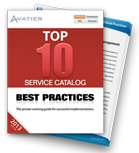Like my father before me, I earn my living, at least in part, as a writer. Unlike my father, however, most of my writing depends upon my knowledge of technical aspects that would have been well beyond his comprehension. That’s not a knock on his intelligence; it’s merely acknowledgement that times have changed and technology has evolved to play a much larger role in business and in life.
Within the technology era itself, we’ve seen immense growth. The ITIL Service Catalog, which IT organizations use to define all of their IT services needed throughout the businesses, is far too static for today’s dynamic world, particularly around the user provisioning needs of identity and access management (IAM). On the other hand, traditional access management solutions are also too limited to address the typical needs presented in a service catalog, so there must be a better way.
Businesses today need to take a cue from Amazon or the app stores for iPhone and Android and offer a full blown IT Store that offers a shopping cart-style interface for requesting access and assets. The IT Store should also offer a variety of choices that marry the offerings of an ITIL service catalog to an identity store including such items as self-service group management or general IT service requests.
The advantages of an IT Store over an ITIL Service Catalog or even an access management solution are many. Here are the top six ways today’s IT Store is different from your dad’s ITIL Service Catalog:
- Self-service: From an organizational perspective, IT Stores save the IT staff significant time. By enabling users to “shop” for their apps based on their levels of access (see “Automation” directly below), it serves to keep IT staff headcount low and provides a level of approval efficiency you don’t get with manual process.
- User experience: According to an article on Statista covering the demographics of online shopping, ecommerce in the U.S. accounted for $289 billion in sales in 2012 and 71% of all Internet users shopped online. Because the process of shopping on line is so familiar, people pick-it up, know what to do and require little training, meaning they can be up and running with what they need sooner rather than later.
- Dynamic experience: In addition to familiarity with the process of online shopping, users are also used to having a range of choices when they go online to shop. Rather than offering just one rarely-changing set of choices like the ITIL Service Catalogs did, IT Stores offer a range of options automatically (see “Automation” in the next point) designed to meet the needs of the individual user/shopper
- Automation: Automated workflow and approval systems are employed to act as identity and access governance policies, granting users access only to those apps and systems for which they have rights
- Audit controls: This is the accounting and reporting side of automation that arms organizations with the details they need to ensure identity and access management is being upheld. The IT Store makes the reporting of activities, transactions and approvals possible at any time for any request type.
- Accounting for Expansion of Users in Today’s Business Community: In my father’s time, users rarely if ever extended beyond the employees of an organization. Today, though, businesses can and often do grant access to third-party vendors, outsourcers, contributors, Ad/Marketing/PR Agencies and even customers. The IT store extends provisioning beyond RBAC (Role Based Access Control) and gives organizations greater flexibility around access provisioning for individuals and groups too.
The complexities of identity and access management and user provisioning in the modern business world dictate that organizations can no longer rely upon a static means for users to obtain applications, rights and accesses.
The IT Store makes self-service as granular as an organization needs it to be while offering the necessary audit controls to track all activities. More important, by making the user experience intuitive and not presenting users with choices that do not relate to them, organizations protect themselves from unauthorized access while users’ choices are made quite clear…unless you’re my father who would still be trying to figure out how to use the mouse (OK, that was a knock).
To learn more about Avatier’s ITIL service catalog solutions watch the Gwinnett Medical Center Customer Testimonial:
 Get the Free Top 10 ITIL Service Catalog Best Practices Workbook
Get the Free Top 10 ITIL Service Catalog Best Practices Workbook
A successul Service Catalog roll-out requires careful planning, strategic decision-making and innovative technology. Before you start your ITIL service catalog initiative, learn from industry experts and sidestep the challenges that typically derail projects. Get our Top 10 Service Catalog Best Practices — The proven guide for successful implementations.




